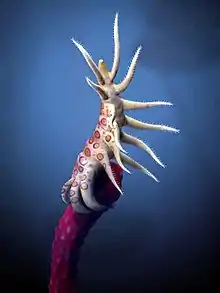Luolishaniidae
The Luolishaniidae or Luolishaniida[2] are a group of lobopodians with setiferous forelimbs known from the Cambrian period.[3] The presence of thorn-shaped sclerites arranged as three per segment is diagnostic. The type genus is based on Luolishania longicruris Hou and Chen, 1989, from the Chengjiang Lagerstatte, South China. They are presumed to have been filter feeders. New specimens of the previously enigmatic Facivermis show that it was a sessile tube-dweller, and part of this group.[4]
| Luolishaniidae | |
|---|---|
 | |
| Ovatiovermis life restoration | |
| Scientific classification | |
| Kingdom: | Animalia |
| (unranked): | Panarthropoda |
| Phylum: | †"Lobopodia" |
| Family: | †Luolishaniidae |
| Genera | |
|
Acinocricus | |
References
- Jean‐Bernard Caron; Cédric Aria (2020). "The Collins' monster, a spinous suspension‐feeding lobopodian from the Cambrian Burgess Shale of British Columbia". Palaeontology. 63 (6): 979–994. doi:10.1111/pala.12499.
- Caron & Aria (2020) elevated this group to the rank of order Luolishaniida, while also naming new family Collinsovermidae within that order, containing the genera Acinocricus, Collinsium and Collinsovermis. See: Jean‐Bernard Caron; Cédric Aria (2020). "The Collins' monster, a spinous suspension‐feeding lobopodian from the Cambrian Burgess Shale of British Columbia". Palaeontology. 63 (6): 979–994. doi:10.1111/pala.12499.; Jean‐Bernard Caron; Cédric Aria (2020). "Corrigendum: The Collins' monster, a spinous suspension‐feeding lobopodian from the Cambrian Burgess Shale of British Columbia". Palaeontology. 63 (6): 995–996. doi:10.1111/pala.12509.
- Hou, X.; Bergström, J. A. N. (1995). "Cambrian lobopodians-ancestors of extant onychophorans?". Zoological Journal of the Linnean Society. 114: 3–19. doi:10.1111/j.1096-3642.1995.tb00110.x.
- Howard, Richard J.; Hou, Xianguang; Edgecombe, Gregory D.; Salge, Tobias; Shi, Xiaomei; Ma, Xiaoya (February 2020). "A Tube-Dwelling Early Cambrian Lobopodian". Current Biology. 30 (8): 1529–1536.e2. doi:10.1016/j.cub.2020.01.075. PMID 32109391.
This article is issued from Wikipedia. The text is licensed under Creative Commons - Attribution - Sharealike. Additional terms may apply for the media files.